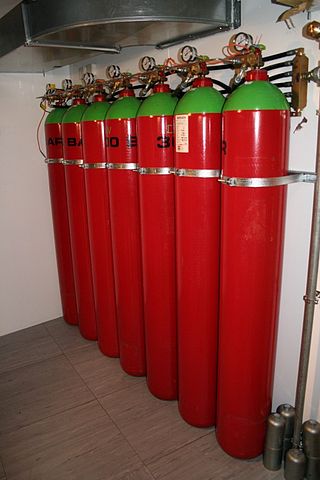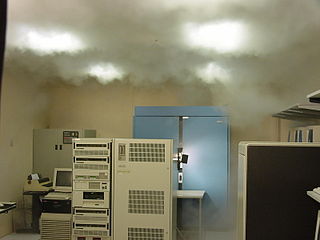
A fire sprinkler system is an active fire protection method, consisting of a water supply system providing adequate pressure and flowrate to a water distribution piping system, to which fire sprinklers are connected. Although initially used only in factories and large commercial buildings, systems for homes and small buildings are now available at a cost-effective price.

A fire hydrant, fireplug, or firecock (archaic) is a connection point by which firefighters can tap into a water supply. It is a component of active fire protection. Underground fire hydrants have been used in Europe and Asia since at least the 18th century. Above-ground pillar-type hydrants are a 19th-century invention.
Bromotrifluoromethane, commonly referred to by the code numbers Halon 1301, R13B1, Halon 13B1 or BTM, is an organic halide with the chemical formula CBrF3. It is used for gaseous fire suppression as a far less toxic alternative to bromochloromethane.

The National Fire Protection Association (NFPA) is a U.S.-based international nonprofit organization devoted to eliminating death, injury, property, and economic loss due to fire, electrical, and related hazards. As of 2023, the NFPA claims to have 50,000 members and 9,000 volunteers working with the organization through its 250 technical committees.

Fire safety is the set of practices intended to reduce destruction caused by fire. Fire safety measures include those that are intended to prevent the ignition of an uncontrolled fire and those that are used to limit the spread and impact of a fire.

A fire sprinkler or sprinkler head is the component of a fire sprinkler system that discharges water when the effects of a fire have been detected, such as when a predetermined temperature has been exceeded. Fire sprinklers are extensively used worldwide, with over 40 million sprinkler heads fitted each year. In buildings protected by properly designed and maintained fire sprinklers, over 99% of fires were controlled by fire sprinklers alone.
This is a glossary of firefighting equipment.

Gaseous fire suppression, also called clean agent fire suppression, is the use of inert gases and chemical agents to extinguish a fire. These agents are governed by the National Fire Protection Association (NFPA) Standard for Clean Agent Fire Extinguishing Systems – NFPA 2001 in the US, with different standards and regulations elsewhere. The system typically consists of the agent, agent storage containers, agent release valves, fire detectors, fire detection system, agent delivery piping, and agent dispersion nozzles.
SimplexGrinnell, a subsidiary of Johnson Controls, is an American company specializing in active fire protection systems, communication systems and testing, inspection and maintenance services. The company headquarters is in Boca Raton, Florida; corporate sales and marketing offices are in Westminster, Massachusetts, and the company has about 160 district offices throughout North America. It is currently the largest fire protection company in the world.
Fire prevention is a function of many fire departments. The goal of fire prevention is to educate the public on the precautions which should be taken to prevent potentially harmful fires and how to survive these fires if they do occur. It is a proactive method of preventing fire-based emergencies and reducing the damage caused by them. Many fire departments have one or more Fire Prevention Officers, which may also be a routine duty of firefighters.

Fireproofing is rendering something resistant to fire, or incombustible; or material for use in making anything fire-proof. It is a passive fire protection measure. "Fireproof" or "fireproofing" can be used as a noun, verb or adjective; it may be hyphenated ("fire-proof").

A fire pump usually refers to a pressure-increasing component of the water supply for fixed-place fire suppression systems such as fire sprinklers, standpipes, and foam systems. Fire pumps are also a critical component integrated into fire trucks and fire boats, and serve a similar purpose boosting water supplies for firefighting hose operations.

Fire protection is the study and practice of mitigating the unwanted effects of potentially destructive fires. It involves the study of the behaviour, compartmentalisation, suppression and investigation of fire and its related emergencies, as well as the research and development, production, testing and application of mitigating systems. In structures, be they land-based, offshore or even ships, the owners and operators are responsible to maintain their facilities in accordance with a design-basis that is rooted in laws, including the local building code and fire code, which are enforced by the authority having jurisdiction.
Active fire protection (AFP) is an integral part of fire protection. AFP is characterized by items and/or systems, which require a certain amount of motion and response in order to work, contrary to passive fire protection.

Monoammonium phosphate, ABC Dry Chemical, ABC Powder, tri-class, or multi-purpose dry chemical is a dry chemical extinguishing agent used on class A, class B, and class C fires. It uses a specially fluidized and siliconized monoammonium phosphate powder. ABC dry chemical is usually a mix of monoammonium phosphate and ammonium sulfate, the former being the active component. The mix between the two agents is usually 40–60%, 60–40%, or 90–10% depending on local standards worldwide. The USGS uses a similar mixture, called Phos Chek G75F.

A fire extinguisher is a handheld active fire protection device usually filled with a dry or wet chemical used to extinguish or control small fires, often in emergencies. It is not intended for use on an out-of-control fire, such as one which has reached the ceiling, endangers the user, or otherwise requires the equipment, personnel, resources or expertise of a fire brigade. Typically, a fire extinguisher consists of a hand-held cylindrical pressure vessel containing an agent that can be discharged to extinguish a fire. Fire extinguishers manufactured with non-cylindrical pressure vessels also exist but are less common.

Automatic fire suppression systems control and extinguish fires without human intervention. Examples of automatic systems include fire sprinkler system, gaseous fire suppression, and condensed aerosol fire suppression. When fires are extinguished in the early stages loss of life is minimal since 93% of all fire-related deaths occur once the fire has progressed beyond the early stages.

Sprinkler fitting is an occupation consisting of the installing, testing, inspecting, and certifying of automatic fire suppression systems in all types of structures. Sprinkler systems installed by sprinkler fitters can include the underground supply as well as integrated overhead piping systems and standpipes. The fire suppression piping may contain water, air, antifreeze, gas or chemicals as in a hood system, or a mixture producing fire retardant foam.
Water transportation and distribution networks require hydraulic calculations to determination the flowrate and pressure characteristics at one or several consumption points and the water supply flowrate and pressures needed to meet the design requirements.
Home safety is the awareness of risks and potential dangers in and around a home that may cause bodily harm, injury, or even death to those living there.












